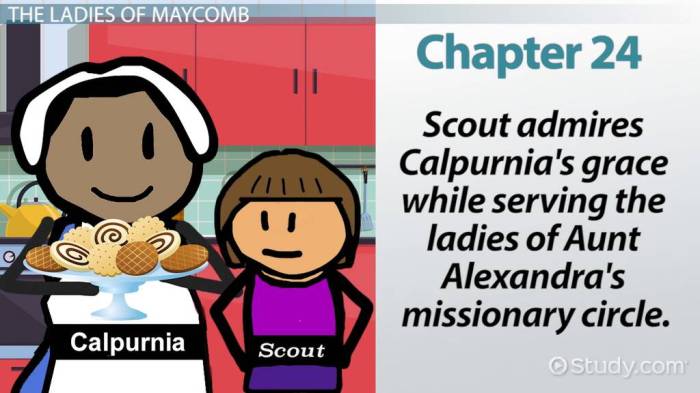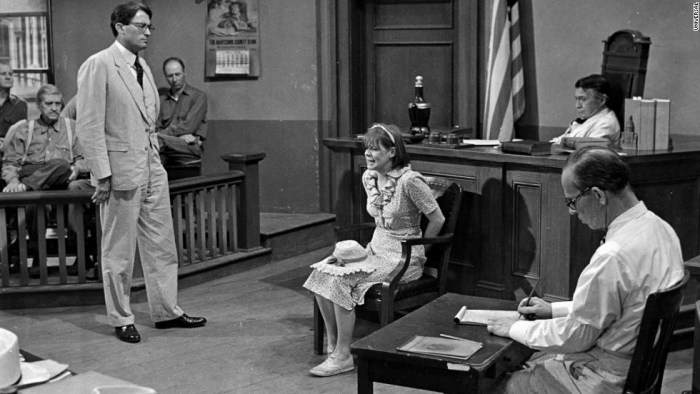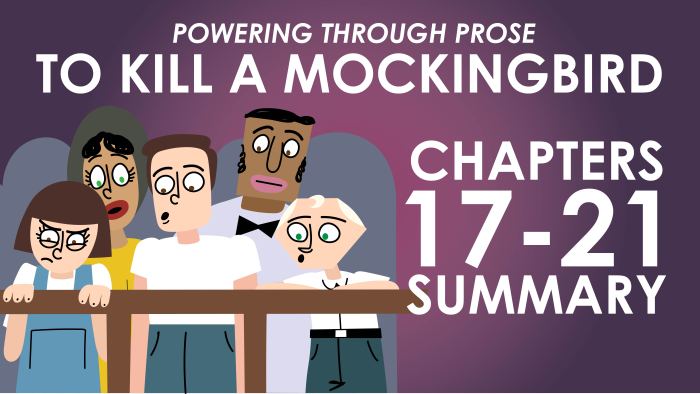Summary of chapter 18 in to kill a mockingbird – Chapter 18 of Harper Lee’s To Kill a Mockingbird marks a pivotal turning point in the narrative, as the trial of Tom Robinson reaches its dramatic conclusion and the children confront the harsh realities of prejudice and injustice. Through the eyes of Scout Finch, readers witness the transformative events that shape the characters and explore timeless themes of justice, innocence, and courage.
As Bob Ewell’s vengeful attack on the children unfolds, the trial of Tom Robinson becomes a microcosm of the societal tensions that divide Maycomb. Atticus Finch’s unwavering defense of Tom, despite overwhelming odds, highlights the importance of standing up for what is right, even in the face of adversity.
Key Events

Chapter 18 of “To Kill a Mockingbird” is marked by several key events that shape the narrative and explore the novel’s central themes.
Bob Ewell’s Attack on the Children
The chapter opens with Bob Ewell, driven by revenge for his humiliation during the trial, attacking Scout and Jem as they walk home from a Halloween party. This act of violence underscores the depth of Ewell’s prejudice and hatred, and serves as a reminder of the dangers that lurk within the seemingly idyllic town of Maycomb.
The Trial and Verdict for Tom Robinson
The trial of Tom Robinson reaches its conclusion in this chapter, with an all-white jury delivering a guilty verdict despite overwhelming evidence of his innocence. This verdict exposes the pervasive racism within the community and highlights the fragility of justice for African Americans in the Jim Crow South.
The Role of Atticus Finch in the Trial
Atticus Finch, who defended Tom Robinson during the trial, is portrayed as a symbol of courage and integrity. Despite the hopelessness of the case, Atticus fights tirelessly for justice, demonstrating the importance of standing up for what is right, even in the face of overwhelming opposition.
Character Development
Chapter 18 witnesses significant growth and transformation in several key characters.
The Growth and Transformation of Scout Finch
Scout’s experiences in the chapter force her to confront the harsh realities of the adult world and challenge her previous assumptions about the inherent goodness of people. Her encounter with Bob Ewell leaves her shaken but also strengthens her resolve to fight against injustice.
The Evolution of Boo Radley’s Character
Boo Radley, who has been a mysterious and feared figure throughout the novel, emerges as a compassionate and protective character in this chapter. His rescue of Scout and Jem from Bob Ewell reveals his true nature and challenges the prejudices that have kept him isolated from the community.
The Complexities of Bob Ewell’s Character
Bob Ewell’s character is explored in depth in this chapter, revealing his deep-seated racism, violence, and desire for revenge. His actions serve as a cautionary tale about the dangers of unchecked hatred and prejudice.
Themes

Chapter 18 of “To Kill a Mockingbird” explores several key themes:
Justice and Prejudice, Summary of chapter 18 in to kill a mockingbird
The trial of Tom Robinson exposes the deep-rooted prejudice and systemic racism that permeate the community. The guilty verdict highlights the fragility of justice for African Americans and the challenges they face in seeking equal treatment under the law.
Innocence and the Loss of Childhood
Scout’s encounter with Bob Ewell forces her to confront the harsh realities of the adult world and challenges her belief in the inherent goodness of people. This experience marks a turning point in her life, as she begins to understand the complexities and dangers of the world around her.
Courage and the Importance of Standing Up for What is Right
Atticus Finch’s unwavering commitment to justice, despite the hopelessness of Tom Robinson’s case, serves as an example of courage and integrity. His actions demonstrate the importance of standing up for what is right, even when it is difficult or unpopular.
Symbolism: Summary Of Chapter 18 In To Kill A Mockingbird

Chapter 18 of “To Kill a Mockingbird” is rich in symbolism:
The Mockingbird
The mockingbird, which has been a recurring symbol throughout the novel, represents innocence and the loss of innocence. The killing of the mockingbird by Bob Ewell symbolizes the destruction of innocence and the triumph of evil.
The Radley Place
The Radley Place, which has been a symbol of mystery and fear, becomes a place of refuge and safety for Scout and Jem in this chapter. This transformation symbolizes the possibility of redemption and the power of human connection.
The Trial
The trial of Tom Robinson serves as a symbol of the larger struggle for justice and equality in the American South. The guilty verdict exposes the deep-rooted prejudice and systemic racism that permeate society.
Common Queries
What is the significance of Bob Ewell’s attack on the children?
Bob Ewell’s attack on the children serves as a catalyst for the events that follow, revealing the depths of his hatred and the dangers of prejudice.
How does the trial of Tom Robinson reflect the societal tensions in Maycomb?
The trial of Tom Robinson becomes a microcosm of the racial tensions that divide Maycomb, highlighting the deep-seated prejudice and the difficulty of achieving justice for African Americans.
What is the role of Atticus Finch in the trial?
Atticus Finch serves as a beacon of justice and integrity, defending Tom Robinson despite the overwhelming odds and societal pressure.